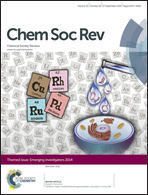Metalloprotein design using genetic code expansion
Abstract
More than one third of all proteins are metalloproteins. They catalyze important reactions such as photosynthesis, nitrogen fixation and CO2 reduction. Metalloproteins such as the olfactory receptors also serve as highly elaborate sensors. Here we review recent developments in functional metalloprotein design using the genetic code expansion approach. We show that, through the site-specific incorporation of metal-chelating unnatural amino acids (UAAs), proton and electron transfer mediators, and UAAs bearing bioorthogonal reaction groups, small soluble proteins can recapitulate and expand the important functions of complex metalloproteins. Further developments along this route may result in cell factories and live-cell sensors with unprecedented efficiency and selectivity.

- This article is part of the themed collection: Chem Soc Rev Emerging Investigators

 Please wait while we load your content...
Please wait while we load your content...